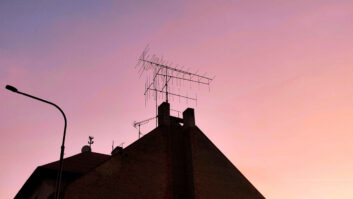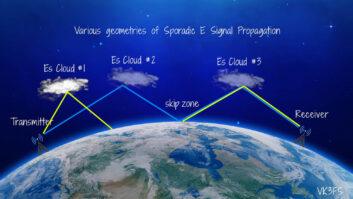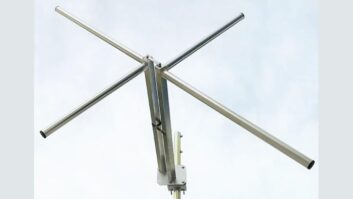Radio Consultants Share More Ideas to Help You Get the Most Out of Your FM Antenna System
How can you get the most out of your FM antenna system? To provide some insight into this subject, three prominent broadcast consulting firms were asked to respond to 15 topics about FM antenna performance.
The participants are Ben Dawson of Hatfield & Dawson; Bob Culver of Lohnes & Culver; and Don Markley of D.L. Markley & Associates. Note that any consultant would need specific site and application information to provide an accurate recommendation for a given situation.
Topic: Comment on the use of parasitics – to make patterns more omni or to favor coverage toward an important market. Are there downsides of parasitics?
Dawson: Any antenna with parasitics is a directional antenna and must be licensed as such, with a measured pattern, and with ERP limited to the maximum lobe value.
Parasitics themselves are generally dipoles, and have substantial downward radiation and therefore are often contributors to high levels of NIER. Directional antennas with parasitics have their gain based on the manufacturer’s assumed (not calculated or measured) gain for the antenna element.
Because the parasitics result in substantial energy radiated in other then the horizontal plane, such antennas virtually always have lower gain than the manufacturer’s rating, and, if possible should be avoided for that reason as well.
Culver: Regarding making a pattern more omni, see my comment on that topic in the Jan. 2 issue.
Regarding favoring coverage toward an important market: Ah, there’s the rub. Pattern circularization so as to identify and minimize pattern variation can be used to minimize the detrimental effects on primary community coverage.
For example, the H-pol and V-pol fields are often different values at different azimuths depending on the antenna type and mounting. You may be able to get adequate H and V field toward the city or you may find some alternative of one or the other will work.
But if you want to favor coverage by using mounting and/or parasitic elements to distort the pattern to increase the ERP in one direction, it is a directional antenna. Assuming you want a directional antenna for conservation of power (i.e., no service over the ocean, avoid reflections off a nearby mountain, FCC Rule 73.215 contour protection, etc.), parasitic elements can work.
However, it is absolutely essential that the antenna have been properly tested (measured) with the parasitic elements, that it is all properly documented and then all the elements, antenna and parasitic elements are properly installed.
Then they must not be changed or damaged in the future. This last point is sometimes difficult to ensure. A chunk of ice, an errant footstep, even a few big birds can upset this. Especially with a Section 73.215 antenna, this constancy of antenna pattern must be ensured.
If you want a directional pattern, you can achieve quite a bit of directionality and variety with panel antennas. Once mounted, unless there is major failure to the elements or feed system, which you should be able to detect, the pattern will stay the same.
Even changes within the tower structure may not have much impact on the pattern, less so than for a side-mounted antenna with parasitic elements.
Markley: It is not legal to use parasitics to improve the signal toward your market unless you declare the antenna to be directional. Unless attempting to improve the omnidirectional characteristics of the antenna by eliminating distortions caused by the tower, parasitics are only used to limit the signal in some directions to protect other stations.
You can use the measured pattern of your antenna to orient it to minimize the impact of pattern minima on desired markets. You cannot legally play with the mounting to cause the pattern to be distorted. That is the same as using parasitics and can result in big trouble with the commission.
Topic: Comment on the use of full-scale vs. reduced-scale pattern test ranges.
Dawson: All modeling, full scale or reduced scale, must be performed by experienced and knowledgeable engineers under controlled, reproducible conditions.
When so performed, it is quite valid within reasonable limits of acceptability. Not all antenna vendors are capable of such efforts, however, and some should be avoided.
Culver: There is only one remaining broadcast antenna full-scale test range that I know of, in Palmyra, Mo. You can build and then test an FM antenna at it but the cost of testing for a ring-style antenna of any size may exceed the cost of the antenna. You would be testing it for a pattern which you had already investigated by scale-model measurements.
Scale-model measurements are quite good, just as good as full scale within a fraction of a dB IF everything is done right.
Scale pattern testing at about 450 percent of operating frequency is quite common and everyone has had enough practice to get it right by now. If anyone is still having problems doing it right, it is because they have not learned from several decades of experience or they don’t care.
At scale frequencies, everything is smaller by the scale, but all errors in making the model are multiplied by the scale. The range can be smaller because the antenna under test is smaller.
To some extent, reflections can be dealt with easier because only a few hundreds of square feet of absorption material are needed to cover a reflection area that may be most of an acre in a full-scale range, etc.
It just has to be done right. If the need is critical, make sure you know what the manufacturer will be doing and that he knows how to do it right. Take him up on that invitation to visit the range and witness the final measurements for your approval. If he does not offer it, ask for it. Even if you eventually cannot go, have someone there to see what is done.
Markley: We really don’t see much difference between full-scale and reduced-scale pattern test ranges. However, we still prefer full-scale, if available.
This may be an unjustified fear, but we feel that there is less opportunity for error in the full-size range.







